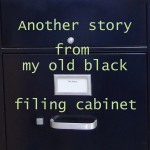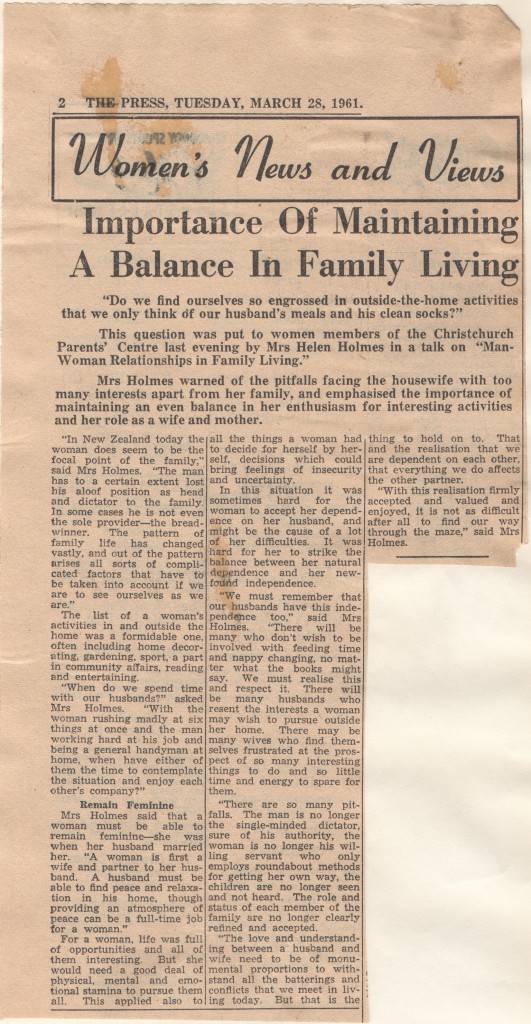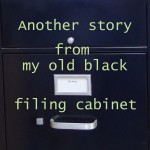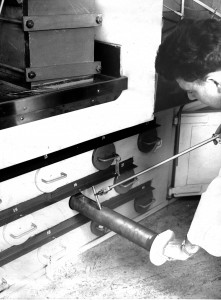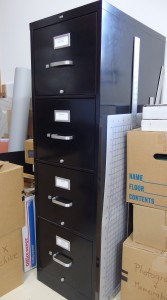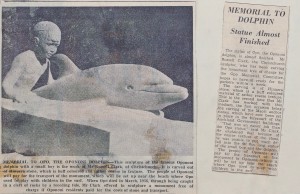Archive for January, 2015
Backstage with Wilma Reading
 When Wilma Reading and I stood in the wings watching the Oscar Peterson Trio perform in Christchurch’s Theatre Royal on January 31, 1961, we were two very young women over-awed by the glamour of our situations. Being backstage as a newspaper reporter was new to me: the blazing lights and deep shadows, the flats with their hanging ropes, the smell of dust, the stagehand snapping at us to keep our voices down. For Wilma it was the experience of being abroad for the first time, and performing with world-famous musicians. “I was scared when I knew I was coming. I am still scared when I go on to the stage. But I guess it will always be like that.”
When Wilma Reading and I stood in the wings watching the Oscar Peterson Trio perform in Christchurch’s Theatre Royal on January 31, 1961, we were two very young women over-awed by the glamour of our situations. Being backstage as a newspaper reporter was new to me: the blazing lights and deep shadows, the flats with their hanging ropes, the smell of dust, the stagehand snapping at us to keep our voices down. For Wilma it was the experience of being abroad for the first time, and performing with world-famous musicians. “I was scared when I knew I was coming. I am still scared when I go on to the stage. But I guess it will always be like that.”
Here is a 1961 audio clip of the great Canadian jazz pianist Oscar Peterson and his trio.
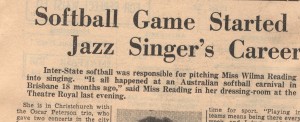 Only eighteen months previously, Wilma Reading was a typist in an office in Cairns, North Queensland, Australia who played softball, hockey and basketball in her leisure time. She made the State team for a big softball carnival held in Brisbane. “On the last evening of the carnival, the softball teams had a get-together in a coffee lounge. Someone persuaded me to get up and sing for them, to add to the fun.”
Only eighteen months previously, Wilma Reading was a typist in an office in Cairns, North Queensland, Australia who played softball, hockey and basketball in her leisure time. She made the State team for a big softball carnival held in Brisbane. “On the last evening of the carnival, the softball teams had a get-together in a coffee lounge. Someone persuaded me to get up and sing for them, to add to the fun.”
Among the patrons of the lounge that evening was the leader of a Brisbane jazz band, who invited her to come and sing for the band. “I had to go home and talk it over with my parents, and they let me go.”
Engagements at a Brisbane hotel led to others in nightspots in the city. Later she went to Sydney, where she signed a five-year contract with a recording company. They are all popular songs. “I prefer jazz, but the company prefers popular tunes, as they sell better.”
In this 1960 video, Reading sings one of the currently popular tunes, “My Little Corner of the World”
Wilma Reading sings “My Little Corner of the World”
Future plans were a little vague, she told me. “I don’t think I could go back to being a typist, although I guess I could if I had to.” America and perhaps Hollywood figured fairly prominently in her dreams. “Still, there’s plenty of time and I have a long way to go.”
Wilma Reading went on to a 40-year career performing with major jazz musicians and on television. She was the first Australian to appear on The Tonight Show Starring Johnny Carson, had a residency at New York City’s Copacabana nightclub, and toured with Duke Ellington.
There’s a long and fascinating transcript of a TV interview with her at
http://www.abc.net.au/tv/messagestick/stories/s3224613.htm
As we stood in the wings that January 1961 evening, she confided that her main worry was how she would get on with the famous Oscar Peterson Trio. “Many musicians have no time for vocalists, but I have found them wonderfully kind and helpful. They are very natural and friendly, and very good to work with. They have given me a lot more confidence than I had before. Aren’t they amazing?” she whispered as the three imposingly large black men pulled sweet sounds from piano, bass and drums.
Maureen is exploring the contents of an old black filing cabinet in her attic, which contains 55 years of her writing notes and memorabilia.
Women’s Lives in 1960s New Zealand
New Zealand social mores were clear when I was growing up in the 1940s and ‘50s: a woman’s place was in the home, taking care of husband and children. A few women (like my mother-in-law) worked after they had children, but the job options were few.
The staff at Christchurch’s The Press newspaper was overwhelmingly male. When I started in 1960, there was only one other woman reporter, besides myself, in the general reporting pool. A vacancy occurred in the Women’s Department, secluded in a separate little office down the hall. The other woman reporter, older and wiser about gender issues, adamantly refused to take it. I didn’t want to go either. I was having a ball scouring the big city hotels for interesting overseas visitors, interviewing artists, musicians and others with fascinating careers and histories. But I was not given a choice. Fortunately the women’s page editor, Tui Thomas, was sympathetic to my lack of interest in fashion and the social scene, and set me to reporting on meetings of various organizations focused on women and families.
I cringed when I first re-read this clipping from my scrapbook, with its sexist stereotypes. Looking more carefully, I sense the speaker’s unease. By the early 1960s, change was in the air. I don’t remember who Mrs Holmes was, but I imagine her as an older woman struggling to reconcile traditional values with the emerging demand by a younger generation of women for an expanded role in the world outside the home. I’ve appended a transcription, in case you have trouble reading the old newsprint.
Maureen is exploring the contents of an old black filing cabinet in her attic, which contains 55 years of her writing notes and memorabilia.
The Press, March 28, 1961 (transcription)
Importance of Maintaining a Balance in Family Life
“Do we find ourselves so engrossed in outside-the-home activities that we only think of our husband’s meals and his clean socks?”
This question was put to women members of the Christchurch Parents’ Centre last evening by Mrs Helen Holmes in a talk on “Man-Woman Relationships in Family Living.”
Mrs Holmes warned of the pitfalls facing the housewife with too many interests apart from her family, and emphasized the importance of maintaining an even balance in her enthusiasm for interesting activities and her role as a wife and mother.
“In New Zealand today the woman does seem to be the focal point of the family,” said Mrs Holmes. “The man has to a certain extent lost his aloof position as head and dictator to the family. In some cases he is not even the sole provider—the breadwinner. The pattern of family life has changed vastly, and out of the pattern arises all sorts of complicated factors that have to be taken into account if we are to see ourselves as we are.”
The list of a woman’s activities in and outside the home was a formidable one, often including home decorating, gardening, sport, a part in community affairs, reading and entertaining.
“When do we spend time with our husbands?” asked Mrs Homes. “With the woman rushing madly at six things at once and the man working hard at his job and being a general handyman at home, when have either of them the time to contemplate the situation and enjoy each other’s company?”
Mrs Holmes said that a woman must be able to remain feminine—as she was when her husband married her. “A woman is first a wife and partner to her husband. A husband must be able to find peace and relaxation in his home, though providing an atmosphere of peace can be a full-time job for a woman.”
For a woman, life was full of opportunities and all of them interesting. But she would need a good deal of physical, mental and emotional stamina to pursue them all. This applied also to all the things a woman had to decide for herself, by herself, decisions which could bring feelings of insecurity and uncertainty.
In this situation, it was sometimes hard for the woman to accept her dependence on her husband, and might be the cause of a lot of her difficulties. It was hard for her to strike the balance between her natural dependence and her new-found independence.
“We must remember that our husbands have this independence too,” said Mrs Holmes. “There will be many who don’t wish to be involved with feeding time and nappy changing, no matter what the books might say. We must realize this and respect it. There will be many husbands who resent the interests a woman may wish to pursue outside her home. there may be many wives who find themselves frustrated at the prospect of so many interesting things to do and so little time and energy to spare for them.
“There are so many pitfalls. The man is no longer the single-minded dictator, sure of his authority, the woman is no longer his willing servant who only employs roundabout methods for getting her own way, the children are no longer seen and not heard. The role and status of each member of the family are no longer clearly defined and accepted.
Tooth Fairy Tests for Strontium-90
While he was completing his degree, my husband Tony worked as a physicist at New Zealand’s National Radiation Laboratory in Christchurch. One of his tasks was testing for the presence of the radioactive isotope Strontium-90 in children’s milk teeth This 1960 photograph shows him working in the lab.
Since the end of World War II in 1945, the United States, along with its allies France and Britain, used the Pacific region north of New Zealand as a testing ground for nuclear weapons. By the mid-1950s, casual attitudes about fallout from these tests had given way to concern. In 1957 the New Zealand Government charged its Department of Health with monitoring environmental radioactive contamination in New Zealand and the Pacific areas with which New Zealand was associated. Since the National Radiation Laboratory in Christchurch was already monitoring radioactive pollution and controlling the safe use of ionizing radiation in medicine, education, research and industry, it seemed a logical extension to extend its responsibilities to collecting samples, analyzing and interpreting data on environmental levels of radioactivity.
The idea of using of children’s milk teeth most likely came from the Baby Tooth Survey. This project was started in the US by the Greater St. Louis Citizens’ Committee for Nuclear Information, in conjunction with Saint Louis University and the Washington University School of Dental Medicine, and inspired similar initiatives in other parts of the world.
Strontium-90, which is chemically similar to calcium, is absorbed from water and dairy products into bones and teeth, and has been linked to bone cancer and leukemia.
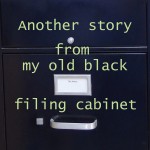 In New Zealand, evidence from the National Radiation Laboratory’s monitoring efforts helped moved the country toward opposition to French nuclear tests at Mururoa and to American warships’ visits to New Zealand.
In New Zealand, evidence from the National Radiation Laboratory’s monitoring efforts helped moved the country toward opposition to French nuclear tests at Mururoa and to American warships’ visits to New Zealand.
—–
Maureen is exploring the contents of an old black filing cabinet in her attic, which contains 55 years of her writing notes and memorabilia.
Dolphins of Yesteryear
A 55-year-old news clipping brings back memories
An old black metal filing cabinet sits in my cluttered attic. Stuffed into its four drawers are fifty-five years of my stories, some published, most not. Sooner or later someone will have to dispose of all the dog-eared pages and travel-worn manuscript boxes. In the meantime, I’ve set myself a little project for this blog: go through the files and find pieces of my past that you, my readers, might find interesting.
Here’s one, to start us off. On January 6, 1960, I was fresh out of college, and this was my first day on the job as a cub reporter at The Press, Christchurch, New Zealand’s morning newspaper. My boss, the city editor, handed me a four-year-old clipping about the death of Opo, a bottlenose dolphin who chose to join children at play in the surf at Opononi, a beach settlement in the Northland region. The grieving residents had commissioned a statue. “Here, update this story,” he said. “The sculptor lives in Christchurch. His phone number’s in the book. I’ve heard he’s nearly finished.”
I had a pleasant conversation with Russell Clark, the sculptor, who was making the sculpture free of charge as his tribute to Opo. It is of Hinuera stone, which is buff colored and coarse in texture. The sculpture was indeed nearly finished, and would be shipped to Opononi the following week. I was so proud when my little story appeared exactly as written, along with a nice photograph, in the next morning’s edition, having survived unscathed the eagle eyes of The Press’s copy editors, gruff eminences who ruled from a curved dais in back of the press room.
I did not meet Opo, but have my own dolphin memory. We were returning from a family vacation on Tuhua, an island offshore from Tauranga. The day was brilliantly sunny, the launch was bouncing through waves, and I had just learned that I’d been awarded a national scholarship to attend university. A school of dolphins surrounded the boat. Leaping joyously through the waves, they escorted us back to land. As I stood at the bow, I felt like a princess.
